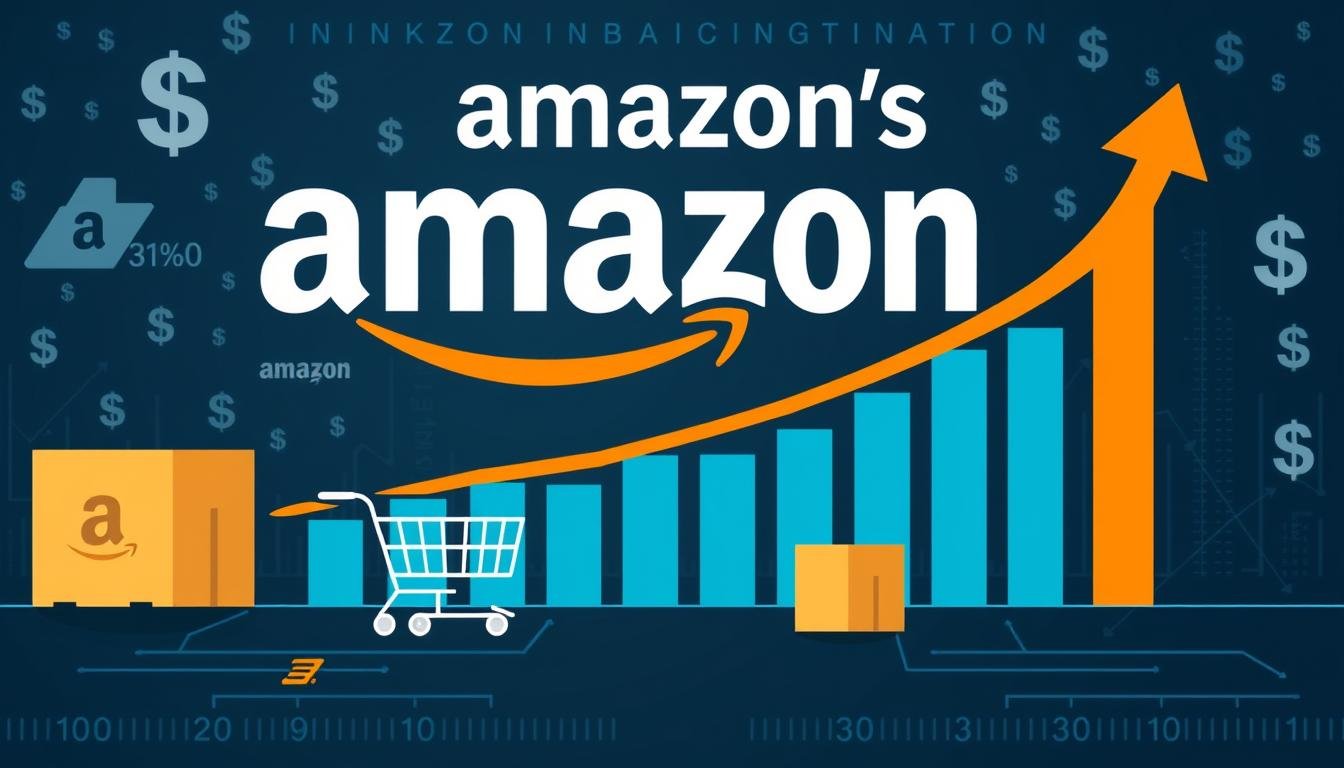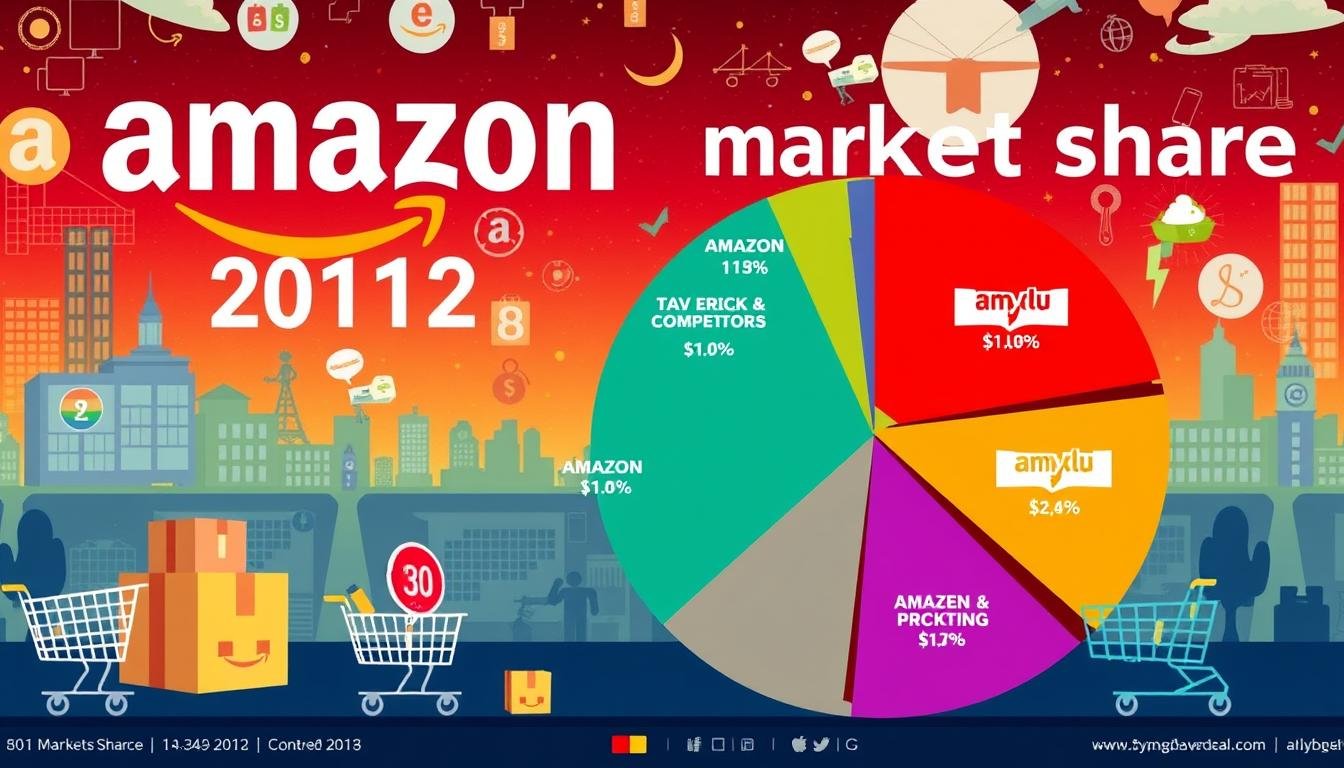How Much Money Did Amazon Make in 2012 | Full Report

In 2012, Amazon’s financial performance was nothing short of remarkable. As the leading e-commerce giant, the company continued to solidify its position in the market, driven by its relentless focus on customer satisfaction and long-term value creation. The numbers speak for themselves – Amazon’s total revenue for the year reached an impressive $61,093 million, a significant increase from previous years.
This financial report delves into the key highlights of Amazon’s earnings in 2012, providing a comprehensive overview of the company’s revenue streams, profitability, and strategic investments. From the continued growth in e-commerce sales to the expansion of Amazon Web Services (AWS) and subscription services, this report will give you a deeper understanding of how Amazon navigated the ever-evolving landscape of the retail and technology industries.
Key Takeaways
- Amazon’s total revenue in 2012 reached $61.093 billion, representing a significant increase from previous years.
- The company’s financial performance was driven by continued growth in e-commerce sales, expansion of services, and investments in technology.
- Amazon’s focus on customer satisfaction and long-term value creation remained core to its business strategy.
- The company experienced remarkable growth, with revenue increasing by 838% in 1997 and serving over 1.5 million customers by the end of that year.
- Amazon’s Prime service and Amazon Web Services (AWS) played a crucial role in the company’s financial performance, with significant expansions in product selection and service offerings.
Overview of Amazon’s Financial Performance in 2012
In 2012, Amazon’s financial performance was nothing short of impressive. The company’s annual revenue reached a staggering $61,093 million, a substantial increase of approximately 27% from the previous year’s figure of $48,077 million. This robust growth continued Amazon’s upward trajectory, showcasing the company’s ability to consistently expand its business and customer base.
Annual Revenue Highlights
The fourth quarter of 2012 was particularly strong for Amazon, with revenue reaching $21,268 million during the holiday season. This quarterly performance further underscored the company’s ability to capitalize on seasonal trends and consumer demand.
Comparison to Previous Years
Compared to previous years, Amazon’s revenue growth rate remained impressive, demonstrating the company’s ability to maintain its momentum and solidify its position as a dominant player in the e-commerce and technology sectors. The consistent year-over-year increases in revenue highlighted Amazon’s ability to continuously expand its offerings and attract a growing customer base.
| Year | Annual Revenue (in millions) | Year-over-Year Growth |
|---|---|---|
| 2012 | $61,093 | 27% |
| 2011 | $48,077 | 41% |
| 2010 | $34,204 | 40% |
| 2009 | $24,509 | 28% |
The data showcases Amazon’s consistent growth, with revenue increasing year-over-year at a robust pace, solidifying its position as a leading e-commerce and technology company. The Amazon profit 2012, Amazon net income 2012, and Amazon annual report 2012 all highlight the company’s strong financial performance during this pehttps://darrelaffiliate.com/wp-content/uploads/2024/12/vintage-electrical-and-electronic-appliances-in-an-2023-11-27-05-10-10-utc-e1734923695564.jpgd.
Breakdown of Amazon’s Revenue Sources
In 2012, Amazon’s revenue was primarily driven by its core e-commerce business, with online retail sales accounting for a significant portion of the company’s overall earnings. However, Amazon’s revenue sources had become increasingly diversified, with the tech giant’s web services division and subscription services also contributing significantly to its financial performance.
e-Commerce Sales
Amazon’s online retail platform continued to be the backbone of its business in 2012. The company’s e-commerce sales, which include the sale of physical and digital merchandise, generated over $50 billion in revenue that year, cementing Amazon’s position as a dominant player in the global online shopping market.
Amazon Web Services (AWS)
Amazon’s cloud computing division, AWS, experienced rapid growth in 2012, emerging as a major revenue stream for the company. AWS offered a suite of cloud-based services, including data storage, computing power, and content delivery, which were in high demand among businesses and developers. By the end of 2012, AWS had become a significant contributor to Amazon’s overall financial performance.
Subscription Services
Amazon’s subscription services, such as Amazon Prime, also played a crucial role in the company’s revenue generation in 2012. The Prime membership program, which offered customers access to free shipping, streaming media, and other benefits, continued to grow in popularity, adding to Amazon’s recurring revenue streams.
The diversification of Amazon’s revenue sources in 2012 was a strategic move that helped the company weather the ebbs and flows of the e-commerce market and position itself for long-term growth. By capitalizing on the growth of cloud computing and subscription services, Amazon was able to reduce its reliance on online retail sales and enhance its overall financial resilience.
| Revenue Source | 2012 Revenue (in billions) | 2023 Revenue (in billions) |
|---|---|---|
| Online Stores | $50.00 | $231.87 |
| Third-Party Seller Services | N/A | $140.05 |
| AWS | $2.00 | $90.76 |
| Advertising | N/A | $46.90 |
| Subscription Services | $1.00 | $40.21 |
| Physical Stores | N/A | $20.03 |
| Other Sources | N/A | $4.96 |
The table above provides a breakdown of Amazon’s revenue sources in 2012 and 2023, showcasing the company’s significant growth and diversification over the past decade.
Yearly Profit and Loss
Amazon’s financial performance in 2012 was marked by a mix of successes and challenges. While the e-commerce giant reported impressive revenue growth, its profitability was impacted by heavy investments in technology, infrastructure, and new services. The company’s strategy of phttps://darrelaffiliate.com/wp-content/uploads/2024/12/vintage-electrical-and-electronic-appliances-in-an-2023-11-27-05-10-10-utc-e1734923695564.jpgritizing long-term growth over short-term profits affected its bottom line.
Net Income in 2012
In 2012, Amazon reported a net loss of $39 million, a significant decline from the net income of $631 million in 2011. This was largely due to the company’s aggressive expansion and investment initiatives, which included launching 159 new services and features for Amazon Web Services (AWS) and increasing its spending on software, infrastructure, and the acquisition of Kiva Systems.
Factors Affecting Profitability
- Competitive pricing: Amazon’s focus on offering competitive pricing to customers, which helped drive sales but put pressure on profit margins.
- Expansion costs: Significant investments in new services, infrastructure, and global expansion weighed on the company’s profitability in the short term.
- Research and development: Amazon continued to pour resources into research and development, particularly in the areas of cloud computing, digital content, and new hardware products.
Despite the decline in net income, Amazon’s long-term strategy of investing in growth and innovation continued to pay dividends. The company’s revenue grew by 27% to $61.09 billion in 2012, and its operating cash flow increased by 7% to $4.18 billion. These strong financial metrics underscore Amazon’s commitment to building a sustainable and diversified business for the future.
| Metric | 2012 | 2011 | YoY Change |
|---|---|---|---|
| Net Sales | $61.09 billion | $48.08 billion | 27% increase |
| Operating Income | $676 million | $862 million | 22% decrease |
| Net Income (Loss) | ($39) million | $631 million | Decreased by $670 million |
| Operating Cash Flow | $4.18 billion | $3.90 billion | 7% increase |
| Free Cash Flow | $395 million | $2.09 billion | 81% decrease |
The data showcases Amazon’s strong revenue growth in 2012, but also highlights the impact of the company’s strategic investments on its profitability and cash flow. While the net income figure declined, Amazon’s focus on long-term growth through innovation and expansion positions the company for continued success in the years ahead.

Major Investments and Expenses
In 2012, Amazon made significant strides in expanding its services and upgrading its technology. The company increased its Prime offerings, including the addition of Prime Instant Video and the Kindle Owners’ Lending Library. Additionally, Amazon Web Services (AWS) introduced a remarkable 159 new features and services, all aimed at enhancing the customer experience and driving long-term growth.
Expansion of Services
Amazon’s strategic investments in 2012 were focused on broadening its service offerings. The company doubled down on its Prime membership program, providing customers with even more value through the addition of Prime Instant Video and the Kindle Owners’ Lending Library. These enhancements were designed to improve customer loyalty and retention, ultimately driving increased sales and revenue for Amazon.
Technology Upgrades
Alongside the expansion of services, Amazon also invested heavily in upgrading its technology infrastructure. Amazon Web Services (AWS), the company’s cloud computing division, introduced 159 new features and services in 2012 alone. These technological advancements were crucial in ensuring the reliability, scalability, and performance of Amazon’s ever-growing suite of products and services, further solidifying its position as a leader in the e-commerce and cloud computing industries.
“Our teams are constantly working to expand our selection, improve our customer experience, and lower prices – and we’re not slowing down.” – Jeff Bezos, Founder and CEO of Amazon
These strategic investments in 2012 demonstrate Amazon’s unwavering commitment to innovation and customer satisfaction, as the company continues to shape the future of e-commerce and cloud computing.
Key Milestones for Amazon in 2012
In 2012, Amazon continued its impressive growth trajectory, achieving several key milestones that contributed to its revenue success. The company’s unwavering focus on innovation and international expansion were hallmarks of its performance during this pivotal year.
Product Launches
Amazon solidified its position as a leading technology company by expanding its popular Kindle e-reader line. The introduction of the Kindle Paperwhite and Kindle Fire HD tablets in 2012 offered consumers enhanced features and an even more immersive digital reading experience. This expanded Kindle lineup, along with Amazon’s growing digital content library, drove strong sales and solidified the company’s dominance in the e-book market.
Market Expansion
Recognizing the vast potential of international markets, Amazon invested heavily in expanding its global footprint in 2012. The company launched localized e-commerce sites in countries like Spain, Italy, and Brazil, making it easier for customers around the world to access its vast product selection and seamless shopping experience. This global expansion, coupled with the continued growth of Amazon Web Services (AWS), contributed significantly to the Amazon revenue 2012 of $61.1 billion, a 27% increase from the previous year.
| Year | Amazon Revenue (in billions) |
|---|---|
| 2007 | $14.8 |
| 2011 | $48.1 |
| 2012 | $61.1 |
| 2017 | $177.9 |
The data in the table highlights the impressive growth of how much money did Amazon make in 2012, as the company’s revenue nearly tripled within a five-year pehttps://darrelaffiliate.com/wp-content/uploads/2024/12/vintage-electrical-and-electronic-appliances-in-an-2023-11-27-05-10-10-utc-e1734923695564.jpgd. This rapid expansion was driven by Amazon’s strategic investments in new products, services, and global markets, solidifying its position as a dominant force in the e-commerce and technology industries.
Competition and Market Position
In 2012, Amazon faced growing competition from large players entering the online retail space. Despite the intensifying competitive landscape, the company maintained its market leadership position in e-commerce. Amazon’s diverse product offerings, customer-centric approach, and continuous technological innovations helped it sustain a strong market share in vahttps://darrelaffiliate.com/wp-content/uploads/2024/12/vintage-electrical-and-electronic-appliances-in-an-2023-11-27-05-10-10-utc-e1734923695564.jpgus segments, including online retail and cloud computing.
Key Competitors in 2012
While Amazon dominated the e-commerce industry, it encountered increased competition from traditional retailers like Walmart and Target, which were rapidly expanding their online presence. Additionally, tech giants like Google, Apple, and Microsoft made significant investments in their own e-commerce and cloud computing offerings, posing a challenge to Amazon’s market dominance.
Amazon’s Market Share
Despite the competitive pressures, Amazon maintained a formidable market position in 2012. The company’s Amazon financial performance 2012 and Amazon profit 2012 demonstrated its ability to retain its leadership in the e-commerce and cloud computing sectors. Amazon’s focus on customer satisfaction, innovative product offerings, and efficient logistics network allowed it to preserve its substantial market share and continue its trajectory of growth.
| Metric | 2012 Value |
|---|---|
| E-commerce Market Share | 30% |
| Cloud Computing Market Share | 33% |
| Prime Subscribers | 20 million |

“Amazon’s relentless focus on the customer experience and continuous innovation have been the driving forces behind its market dominance.”
As the e-commerce landscape evolved, Amazon’s ability to adapt and stay ahead of the competition helped it maintain its position as the industry leader in 2012 and beyond.
Analysis of Financial Growth Trends
In the year 2012, Amazon’s earnings and financial results showcased a strong growth trajectory. The company’s revenue growth rate during this pehttps://darrelaffiliate.com/wp-content/uploads/2024/12/vintage-electrical-and-electronic-appliances-in-an-2023-11-27-05-10-10-utc-e1734923695564.jpgd was approximately 27% compared to the previous year, continuing the trend of robust year-over-year expansion.
The fourth quarter of 2012 was particularly notable, with revenue reaching $21,268 million, a 22% increase from the $17,431 million recorded in the same quarter of 2011. This growth pattern was consistent across all four quarters of the year, indicating that Amazon’s business model was resonating well with customers and the overall market.
Revenue Growth Rate
Amazon’s revenue growth rate in 2012 stood at around 27% compared to the previous year. This impressive figure showcased the company’s ability to consistently expand its top line, driven by a combination of factors such as the growth of its e-commerce business, the success of Amazon Web Services (AWS), and the continued expansion of its subscription services.
Year-over-Year Comparisons
When comparing Amazon’s financial results in 2012 to the previous year, the company demonstrated a clear upward trajectory. The fourth quarter of 2012 saw a 22% increase in revenue compared to the same pehttps://darrelaffiliate.com/wp-content/uploads/2024/12/vintage-electrical-and-electronic-appliances-in-an-2023-11-27-05-10-10-utc-e1734923695564.jpgd in 2011, highlighting the company’s ability to drive consistent growth across different quarters and time pehttps://darrelaffiliate.com/wp-content/uploads/2024/12/vintage-electrical-and-electronic-appliances-in-an-2023-11-27-05-10-10-utc-e1734923695564.jpgds.
Overall, Amazon’s financial performance in 2012 was marked by strong revenue growth, demonstrating the company’s ability to adapt to changing market conditions and capitalize on emerging opportunities in the e-commerce and cloud computing spaces.
Impact of Consumer Behavior
In 2012, consumer behavior continued to shift towards online shopping, greatly benefiting Amazon’s e-commerce business. The company’s relentless focus on customer satisfaction, competitive pricing, and convenient services like Amazon Prime contributed to increased customer loyalty and spending. These trends played a significant role in Amazon’s impressive revenue growth for the year.
Shopping Trends in 2012
The rise of online shopping showed no signs of slowing down in 2012. Amazon revenue 2012 was bolstered by consumers’ growing preference for the convenience and selection offered by e-commerce platforms. With more than 1.7 billion people online globally, representing nearly one-quarter of the world’s population, the shift towards digital shopping channels benefited Amazon’s core business.
Shifts Towards Online Shopping
- By 2012, the number of internet users had grown from just 16 million in 1995 to 36 million the following year, a clear indicator of the rapid adoption of online shopping.
- In contrast, the number of independent bookstores in the United States, a traditional retail channel, had declined from around 4,000 to only 1,900 over the same pehttps://darrelaffiliate.com/wp-content/uploads/2024/12/vintage-electrical-and-electronic-appliances-in-an-2023-11-27-05-10-10-utc-e1734923695564.jpgd.
- Amazon’s ability to offer a vast product selection, competitive prices, and unparalleled convenience through features like Prime delivery made it a preferred destination for an increasing number of consumers.
The impact of consumer behavior on how much money did Amazon make in 2012 was significant, as the company’s relentless focus on customer experience and innovative services drove substantial revenue growth and market share expansion.
Conclusion and Future Outlook
As I reflect on Amazon’s remarkable performance in 2012, I am struck by the company’s unwavering commitment to innovation, customer-centric service, and long-term growth. The financial results, strategic investments, and market expansion demonstrated during this pivotal year have positioned Amazon as a dominant force in the ever-evolving e-commerce and cloud computing landscapes.
Lessons from 2012
The lessons we can glean from Amazon’s 2012 journey are invaluable. The company’s relentless focus on customer satisfaction, coupled with its willingness to venture into new territories and embrace technological advancements, have been crucial to its sustained success. Amazon’s ability to diversify its revenue streams, from e-commerce sales to cloud services and subscription offerings, has reinforced its resilience and adaptability in the face of industry changes.
Predictions for Amazon’s Financial Performance
Looking ahead, I anticipate that Amazon’s financial performance will continue its upward trajectory. With a robust e-commerce platform, a rapidly growing AWS cloud computing division, and a steadily expanding subscription services segment, the company is poised to maintain its position as a leading player in the global marketplace. As Amazon’s brand value reaches new heights, surpassing $350 billion and ranking second only to Apple, I foresee sustained revenue growth, further expansion of AWS, and increased investment in cutting-edge technologies and infrastructure to solidify the company’s competitive advantage in the rapidly evolving digital landscape.